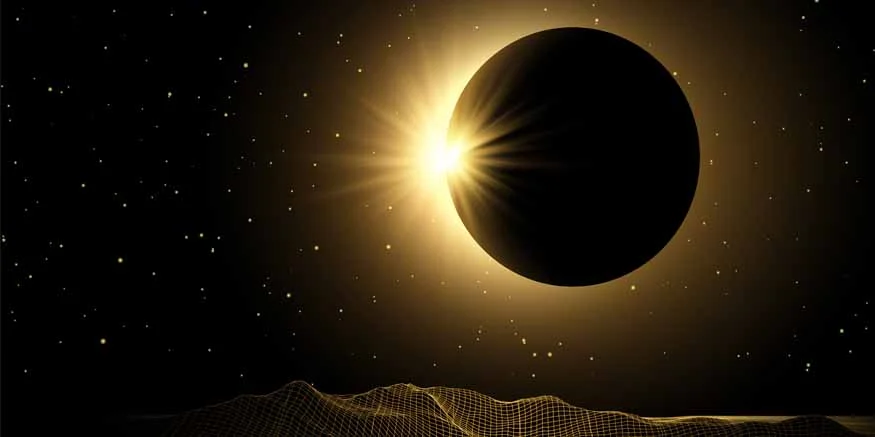Imagine a grand cosmic ballet where the sun, moon, and Earth perform an extraordinary dance. This dance creates a spectacular event known as a solar eclipse, captivating people worldwide. Let’s dive into the magic of solar eclipses, understand their types, learn how to watch them safely, and explore their cultural and historical significance.
Also read: What Is Lunar Eclipse: How and Why It Happens
Introduction to What is a Solar Eclipse
A solar eclipse occurs when the moon moves between the Earth and the sun, casting a shadow on the Earth. This cosmic phenomenon temporarily blocks the sun’s light, creating a mesmerising display. Think of it as the sun playing a game of hide-and-seek with the Earth, where the moon acts as the curtain that briefly closes off the sun’s brilliant light.
Types of Solar Eclipses
- Total Solar Eclipse
- Partial Solar Eclipse
- Full Solar Eclipse
- Total and Partial Solar Eclipse Together
A total solar eclipse happens when the moon completely covers the sun, turning day into night for a short period. This rare and breathtaking event occurs three to four times a year, leaving people in awe as the sky darkens and stars become visible in the daytime.
A partial solar eclipse occurs three to four times a year when the moon covers only a part of the sun. Instead of a complete blackout, you see a crescent shape as the moon takes a bite out of the sun. It’s a beautiful and fascinating sight that gives a glimpse of the cosmic dance.
The full solar eclipse, occurring two to three times a year, is a combination of both total and partial eclipses. In this event, some people witness the moon fully covering the sun, while others see a partial shadow, creating a harmonious celestial ballet.
Occasionally, the universe treats us to a spectacular fusion of total and partial solar eclipses in one event, happening two to three times annually. Imagine seeing the moon completely block the sun while also observing a crescent-shaped sun on the side. It’s a double dose of cosmic magic!
Also read: What Is Satellite: Definition, Types & Facts
How to View a Solar Eclipse Safely
While solar eclipses are stunning, it’s essential to prioritise safety when watching them. Never look directly at the sun without proper protection, as it can harm your eyes. Use solar-viewing glasses or special filters for telescopes to enjoy the show safely. These precautions ensure a memorable and safe experience as you witness the celestial spectacle.
Historical Tales of Solar Eclipses
- Celestial Events Across Time
- Ancient Beliefs and Modern Discoveries
Throughout history, different cultures have observed, recorded, and interpreted solar eclipses. These astronomical events have influenced cultural narratives and beliefs, shaping how people understood the cosmos.
Early civilizations often viewed solar eclipses as symbolic or mythical events. In contrast, modern scientific discoveries provide factual explanations. Exploring these perspectives offers a rich understanding of how solar eclipses have been perceived over time.
Also read: 10 Interesting Facts About Solar System for Kids
Eclipses in Different Cultures
- Indigenous Traditions
- Ancient Accounts
- Cultural Celebrations
- Cultural Views on Celestial Phenomena
- Scientific Discoveries
- Writing Conclusions
Indigenous cultures worldwide have unique perspectives and customs related to solar eclipses. These traditions offer profound insights into their deeply ingrained beliefs and practices surrounding these celestial phenomena.
Historical documents and personal stories across various traditions provide an in-depth understanding of the past significance and continuing influence of solar eclipses on cultural practices.
Communities around the world celebrate solar eclipses with vibrant festivities and rituals. These cultural celebrations highlight the diverse ways in which societies honour these celestial events.
From artistic expressions and religious beliefs to scientific contributions and contemporary perspectives, solar eclipses have multifaceted cultural views. Exploring these aspects reveals the rich tapestry of how different cultures perceive and symbolise these events.
Various cultures have made significant contributions to our scientific knowledge of solar eclipses. These discoveries have played a crucial role in advancing our understanding of astronomy and observation techniques.
Literature offers unique perspectives on the cultural significance and symbolism of solar eclipses. Authors and poets throughout history have portrayed and interpreted these celestial events in diverse ways, enriching our appreciation of their impact.
Also read: Solar System Project for Kids: DIY Science Project Ideas
Embrace the Cosmic Wonder
The next time you hear about a solar eclipse, grab your binoculars, find a good observation point, and prepare to be amazed by the celestial show. The sky is a vast canvas full of mysteries waiting for curious explorers like you to discover!
At EuroSchool, we aim to ignite curiosity and foster a love for the wonders of the universe through clear explanations and engaging storytelling. EuroSchool offers an educational journey that sparks interest and expands knowledge of the celestial marvels unfolding in our skies, from the intricate dance of celestial bodies to the captivating physics behind these cosmic events. Visit EuroSchool to read more interesting posts.









